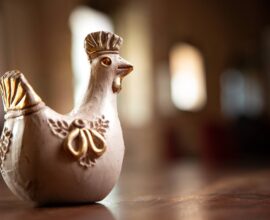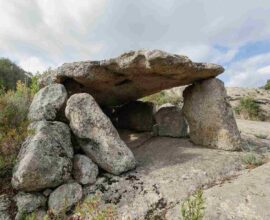Christmas in Sardinia, a journey through the traditions of the island
Christmas in Sardinia: the origins of a celebration loved by adults and children
Christmas in Sardinia is a family celebration. It is rich in warmth, suggestions and ancient traditions, handed down throughout the generations.
In Italian, Christmas is Natale. The word comes from the Latin ‘Natāle’, ellipses of ‘Diem natālem Christi’, the day of Christ’s birth. Furthermore, Natāle comes from ‘natālis’, which derives from ‘nātus’, the perfect participle of the verb ‘nāsci’, to be born.
Christmas is preceded by the Advent and lasts 12 days, as established in the Council of Tours in 567. It runs from December 25 to January 6 (Epiphany of the Lord). The latter is the day that commemorates the first time Jesus showed himself to the public. It also commemorates the visit of the Three Wise men as representatives of the whole Earth.
The first references to Christmas date back to the Commentary on Daniel by St. Hippolytus of Rome (203-204). However, the date of December 25 to indicate the birth of Christ appears for the first time in the Chronographus. This was an illustrated calendar draw by the Roman scholar Furio Dionisio Filocalo around the middle of the 4th century.
In any case, we do not know precisely the historical origins of this festivity. Indeed, there are several hypotheses. 3 are particularly popular.
The first one says that the date of December 25 matches the pagan feast of Natalis Solis Invict, the day of the birth of the Unconquered Sun, and the celebration of the birth of Christ as in the Book of Malachi. This book is part of the Hebrew Bible (Tanakh) and Christian Bible, in which Jesus is described as the new “sun of Justice”.
The second one says that there is a link between Christmas and the Saturnalia festivities. The Romans celebrated the Saturnalia between December 17 and 23 in honor of Saturn, the god of regeneration and agriculture.
The celebrations included sumptuous banquets during which people exchanged small gifts called strennas. Strenna comes from the Latin ‘strēna’ which means ‘gift of good omen’.
People also greeted each other saying “Io Saturnalia” or “Ego tibi optimis Saturnalia auspico”, that is “I wish you a happy Saturnalia”.
Then, some scholars think that there is a connection between Christmas and the Jewish holiday of the Hannukkah, the Redication of the Temple. In fact, Hannukkah falls on the 25th day of Kislev, the lunar month that corresponds to December.
Christmas in Sardinia; what is Sa nott’è e xena?
Christmas traditions in Sardinia often link to the agro-pastoral culture. An example is Sa nott’è e xena, the Night of Supper, which falls on the night of Christmas Eve. In ancient times many shepherds used to go home from transhumance to celebrate Christmas with their loved ones.
During Sa nott’è e xena the whole family gathered around the fireplace, symbol of the festivity. They used to burn Su truncu de xena, a large piece of wood specifically cut for the occasion. According to tradition, the log should have remained lit until the Epiphany to bring luck to the family.
A legend of the city of Nuoro says that also the souls of the family ancestors usually approached the fireplace during that night. And as the writer Grazia Deledda tells in her stories, people always left wine and food on the table for them.
In the past, during Sa nott’è e xena, the elderly entertained children with the stories of Sardinian folklore. But children could also play Sa Tombùla, the bingo, or Su Barralliccu.
The latter was a sort of spinning top with four faces. Each face had an engraved letter; T for ‘tottu’ (all), N for ‘nudda’ (nothing), M for ‘metadi’ (half) and P for ‘poni’ (put).
If the toy stopped on the letter T, the player won the prize – usually nuts and dried fruit. If it stopped on the letter P, they had to forgo a portion of the prize. On Christmas Eve, at midnight, the tolling bells told people the beginning of the Christmas mass.
This mass is still called Sa Miss’è Puddu, the mass of the first crowing of the rooster. In the past, sometimes it was so crowded that the chatter made it difficult to carry it out. It was even common to hear arquebus shots as a sign of jubilation.
With the Synods of Cagliari in 1651 and 1695, the clergy decided to ban the people from celebrating by throwing peanuts or shooting inside the churches.
The Sardinian writer Salvatore Cambosu described the atmosphere of Sa nott’è e xena in his work ‘Bitter Honey’: “It is clear that it takes a village for a child like Jesus to be born every year for the first time. In the city there is no barn with a real donkey and ox. There is no bleating, nor the atrocious cry of the sacrificed pig, slaughtered for the anniversary. In the city it is even a waste of time to look for a kitchen in which the red flower of the burning log blossoms in its black heart”.
During the night of Christmas Eve people also used to donate the so-called Mandada to the poorest families. It was a basket of sausages, cheese and dry sweets that people could consume throughout the year.
Christmas in Sardinia: the unique traditions of the island
Sa noctè e xena is just one of the many Christmas traditions in Sardinia. They often mix religious elements, ancient rites and popular beliefs.
For example, during the night of December 24 in the cathedral of Alghero people can enjoy the evocative Chant of the Sibyl, called Signum Judicii or Señal del Judici. It is a medieval chant that testifies to the deep ties between the city and the Spanish region of Catalonia.
The Sibyls were mythological figures with prophetic virtues and their myth dates back to the ancient Greeks and Romans. On the Christmas Eve chant they announce the return of the Savior on the Day of Judgment.
The chant of the Sibyl is performed strictly in the Catalan language. The Italian Ministry of Industry, Tourism and Commerce declared it an Intangible Asset of Cultural Interest on January 16, 2004. It also became an Intangible Heritage of Unesco since November 16, 2010.
Also in Barbagia region there is no shortage of Christmas traditions. One is Sa Candelaria, celebrated in Orgosolo every December 31st. From 8 in the morning until noon, children between the ages of four and twelve go from house to house repeating “A nolla dàzes sa candelarìa?”, “Can you give us the candelaria?”. For the occasion, women prepare Su cocòne de sa candelarìa, a typical bread to give them along with money, sweets and fruit.
Another ancient Christmas tradition of Barbagia is Su Nenneddu, during which people of the town of Bitti carry in procession a small statue of the Child Jesus while singing and praying.
Do you want to discover the ancient traditions of Sardinia and live a dream holiday in a real paradise? Book a stay at the Forte Village Resort.






